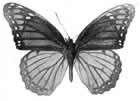Description
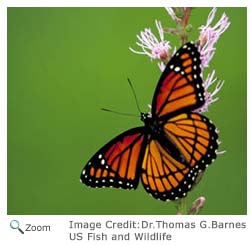 The viceroy butterfly is a brush-footed butterfly. Brush-footed butterflies have tiny, hairy forelegs that look more like brushes than feet and are not used for walking. It is dark orange with black veins. A row of white spots edge its wings. Its color and pattern mimics the monarch butterfly's pattern, except for a black horizontal stripe that crosses the bottom of its back wings. The viceroy caterpillar is white and olive-brown. The viceroy butterfly is a brush-footed butterfly. Brush-footed butterflies have tiny, hairy forelegs that look more like brushes than feet and are not used for walking. It is dark orange with black veins. A row of white spots edge its wings. Its color and pattern mimics the monarch butterfly's pattern, except for a black horizontal stripe that crosses the bottom of its back wings. The viceroy caterpillar is white and olive-brown.
RangeThe viceroy is found in most of the continental United States and in southern Canada and northern Mexico. The viceroy is found throughout New Hampshire.
Habitat
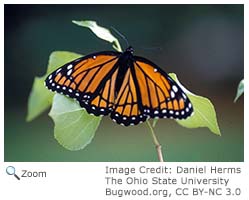 The viceroy butterfly lives in meadows, marshes, swamps, and other wet areas with willow, aspen, and poplar trees. The viceroy butterfly lives in meadows, marshes, swamps, and other wet areas with willow, aspen, and poplar trees. |
|
Diet
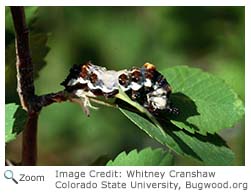 The viceroy caterpillar eats the leaves of willow and poplar trees. The viceroy butterfly eats dung, carrion, fungi, and the nectar of flowers from the Asteraceae family like golden rod, thistles, and asters. The viceroy caterpillar eats the leaves of willow and poplar trees. The viceroy butterfly eats dung, carrion, fungi, and the nectar of flowers from the Asteraceae family like golden rod, thistles, and asters.
Life Cycle 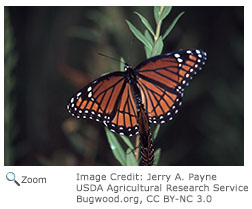 The viceroy mates in the afternoon. The female lays her eggs on the tips of the leaves of poplars and willows. There are usually two or three generations of viceroys born each breeding season. The viceroy mates in the afternoon. The female lays her eggs on the tips of the leaves of poplars and willows. There are usually two or three generations of viceroys born each breeding season.
Behavior
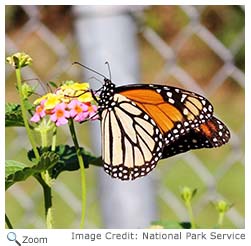 The viceroy and monarch were once thought to exhibit Batesian mimicry, where a harmless species mimics a toxic species. Studies conducted in the early 1990s suggest that the viceroy and the monarch are actually examples of Mullerian mimicry, where two equally toxic species mimic each other to the benefit of each. Just goes to show you there's always something new to discover in the natural world! The viceroy and monarch were once thought to exhibit Batesian mimicry, where a harmless species mimics a toxic species. Studies conducted in the early 1990s suggest that the viceroy and the monarch are actually examples of Mullerian mimicry, where two equally toxic species mimic each other to the benefit of each. Just goes to show you there's always something new to discover in the natural world!
|

